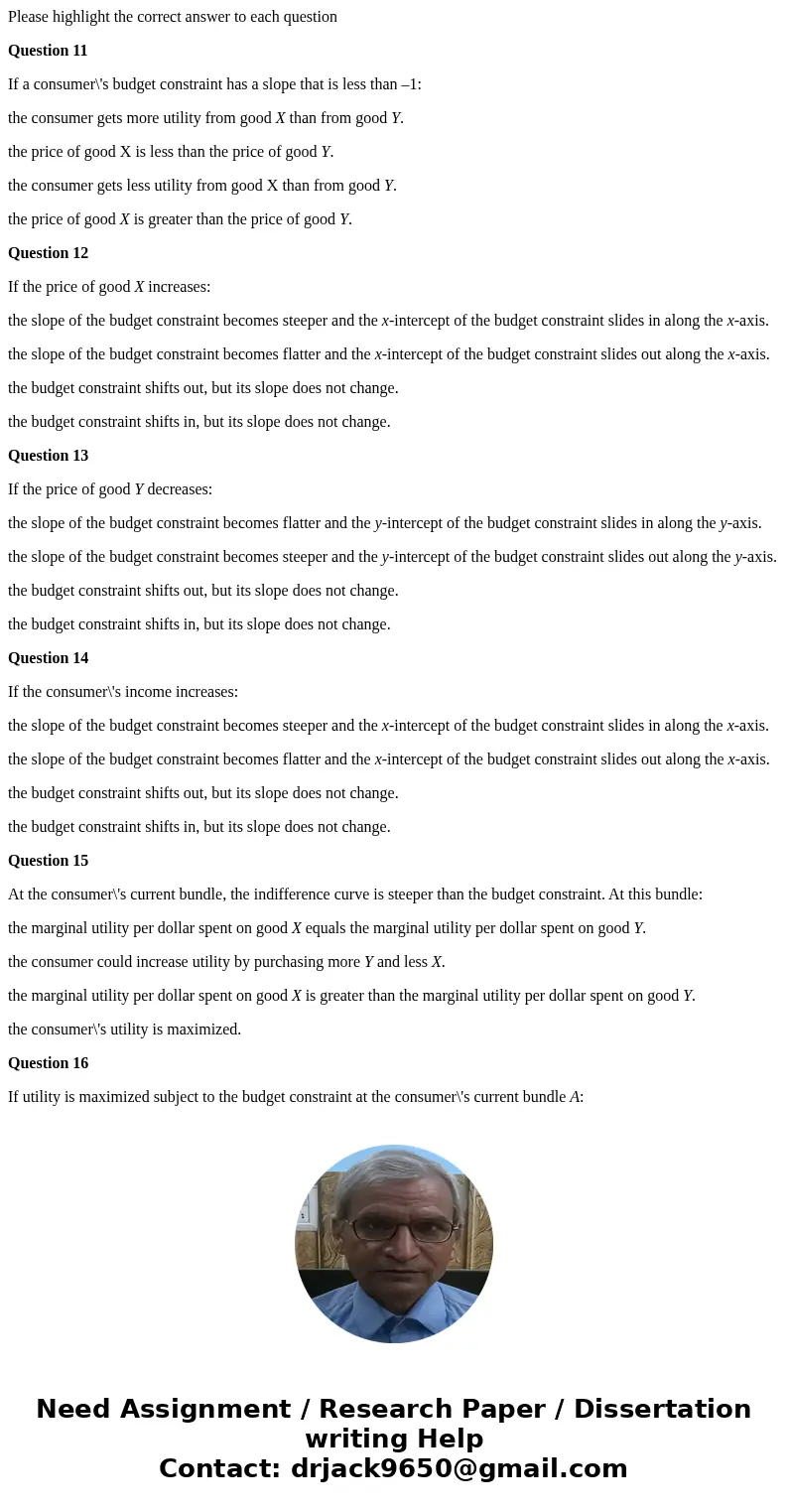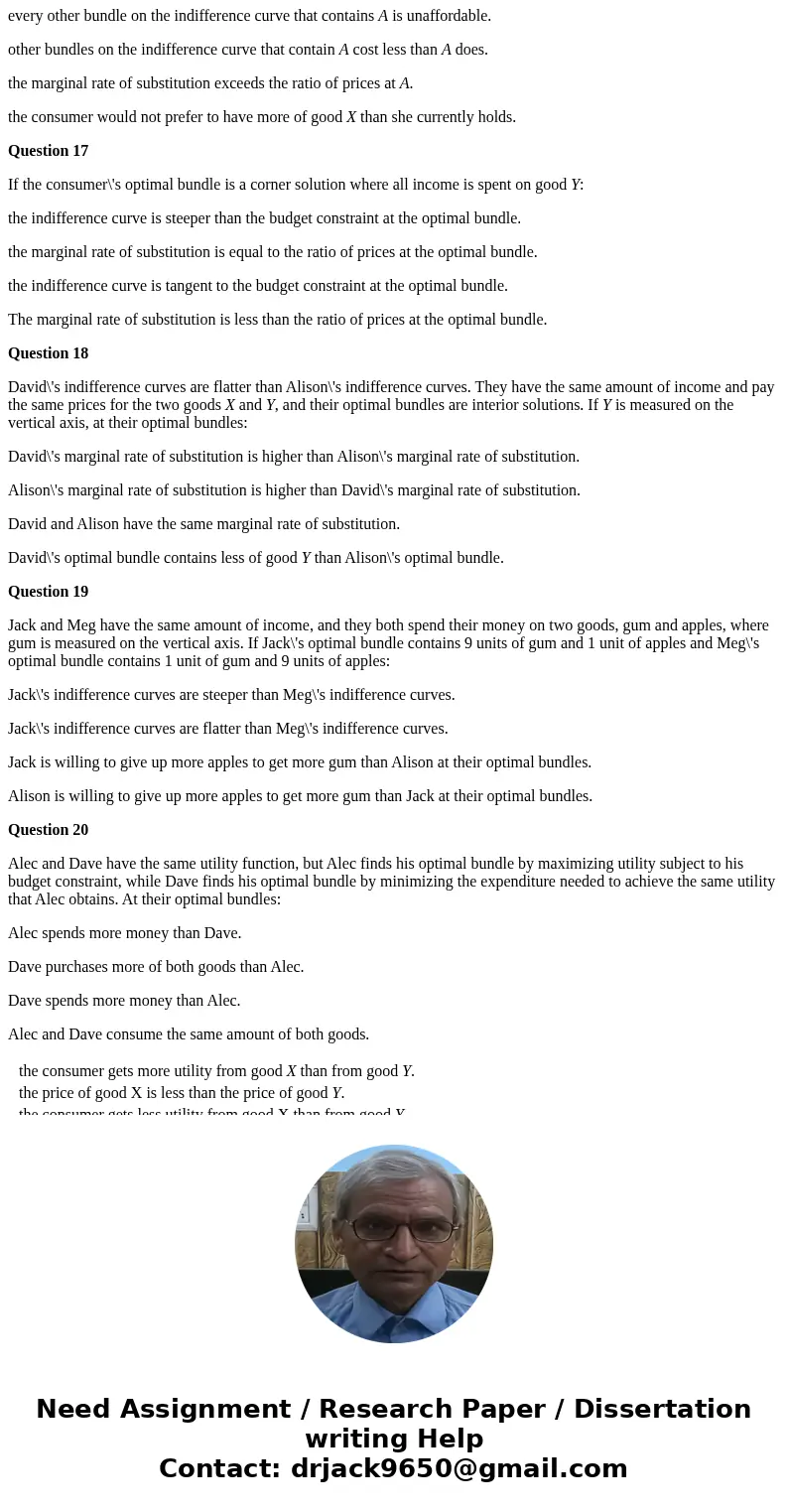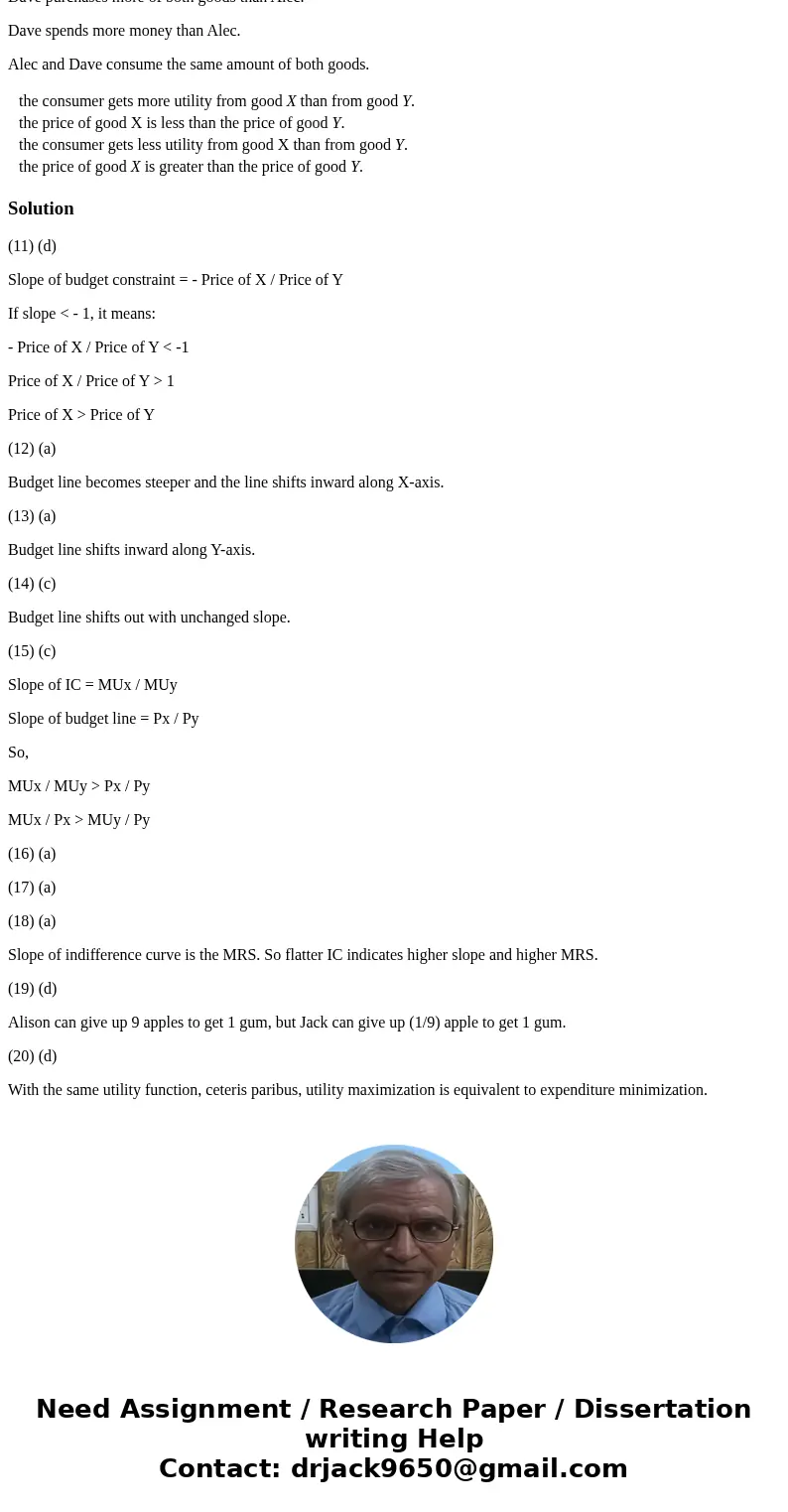Please highlight the correct answer to each question Questio
Please highlight the correct answer to each question
Question 11
If a consumer\'s budget constraint has a slope that is less than –1:
the consumer gets more utility from good X than from good Y.
the price of good X is less than the price of good Y.
the consumer gets less utility from good X than from good Y.
the price of good X is greater than the price of good Y.
Question 12
If the price of good X increases:
the slope of the budget constraint becomes steeper and the x-intercept of the budget constraint slides in along the x-axis.
the slope of the budget constraint becomes flatter and the x-intercept of the budget constraint slides out along the x-axis.
the budget constraint shifts out, but its slope does not change.
the budget constraint shifts in, but its slope does not change.
Question 13
If the price of good Y decreases:
the slope of the budget constraint becomes flatter and the y-intercept of the budget constraint slides in along the y-axis.
the slope of the budget constraint becomes steeper and the y-intercept of the budget constraint slides out along the y-axis.
the budget constraint shifts out, but its slope does not change.
the budget constraint shifts in, but its slope does not change.
Question 14
If the consumer\'s income increases:
the slope of the budget constraint becomes steeper and the x-intercept of the budget constraint slides in along the x-axis.
the slope of the budget constraint becomes flatter and the x-intercept of the budget constraint slides out along the x-axis.
the budget constraint shifts out, but its slope does not change.
the budget constraint shifts in, but its slope does not change.
Question 15
At the consumer\'s current bundle, the indifference curve is steeper than the budget constraint. At this bundle:
the marginal utility per dollar spent on good X equals the marginal utility per dollar spent on good Y.
the consumer could increase utility by purchasing more Y and less X.
the marginal utility per dollar spent on good X is greater than the marginal utility per dollar spent on good Y.
the consumer\'s utility is maximized.
Question 16
If utility is maximized subject to the budget constraint at the consumer\'s current bundle A:
every other bundle on the indifference curve that contains A is unaffordable.
other bundles on the indifference curve that contain A cost less than A does.
the marginal rate of substitution exceeds the ratio of prices at A.
the consumer would not prefer to have more of good X than she currently holds.
Question 17
If the consumer\'s optimal bundle is a corner solution where all income is spent on good Y:
the indifference curve is steeper than the budget constraint at the optimal bundle.
the marginal rate of substitution is equal to the ratio of prices at the optimal bundle.
the indifference curve is tangent to the budget constraint at the optimal bundle.
The marginal rate of substitution is less than the ratio of prices at the optimal bundle.
Question 18
David\'s indifference curves are flatter than Alison\'s indifference curves. They have the same amount of income and pay the same prices for the two goods X and Y, and their optimal bundles are interior solutions. If Y is measured on the vertical axis, at their optimal bundles:
David\'s marginal rate of substitution is higher than Alison\'s marginal rate of substitution.
Alison\'s marginal rate of substitution is higher than David\'s marginal rate of substitution.
David and Alison have the same marginal rate of substitution.
David\'s optimal bundle contains less of good Y than Alison\'s optimal bundle.
Question 19
Jack and Meg have the same amount of income, and they both spend their money on two goods, gum and apples, where gum is measured on the vertical axis. If Jack\'s optimal bundle contains 9 units of gum and 1 unit of apples and Meg\'s optimal bundle contains 1 unit of gum and 9 units of apples:
Jack\'s indifference curves are steeper than Meg\'s indifference curves.
Jack\'s indifference curves are flatter than Meg\'s indifference curves.
Jack is willing to give up more apples to get more gum than Alison at their optimal bundles.
Alison is willing to give up more apples to get more gum than Jack at their optimal bundles.
Question 20
Alec and Dave have the same utility function, but Alec finds his optimal bundle by maximizing utility subject to his budget constraint, while Dave finds his optimal bundle by minimizing the expenditure needed to achieve the same utility that Alec obtains. At their optimal bundles:
Alec spends more money than Dave.
Dave purchases more of both goods than Alec.
Dave spends more money than Alec.
Alec and Dave consume the same amount of both goods.
| the consumer gets more utility from good X than from good Y. | ||
| the price of good X is less than the price of good Y. | ||
| the consumer gets less utility from good X than from good Y. | ||
| the price of good X is greater than the price of good Y. |
Solution
(11) (d)
Slope of budget constraint = - Price of X / Price of Y
If slope < - 1, it means:
- Price of X / Price of Y < -1
Price of X / Price of Y > 1
Price of X > Price of Y
(12) (a)
Budget line becomes steeper and the line shifts inward along X-axis.
(13) (a)
Budget line shifts inward along Y-axis.
(14) (c)
Budget line shifts out with unchanged slope.
(15) (c)
Slope of IC = MUx / MUy
Slope of budget line = Px / Py
So,
MUx / MUy > Px / Py
MUx / Px > MUy / Py
(16) (a)
(17) (a)
(18) (a)
Slope of indifference curve is the MRS. So flatter IC indicates higher slope and higher MRS.
(19) (d)
Alison can give up 9 apples to get 1 gum, but Jack can give up (1/9) apple to get 1 gum.
(20) (d)
With the same utility function, ceteris paribus, utility maximization is equivalent to expenditure minimization.



 Homework Sourse
Homework Sourse